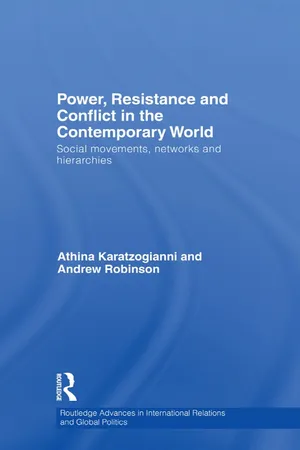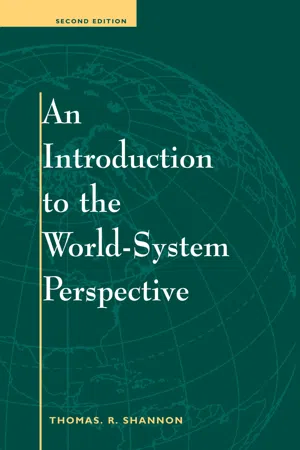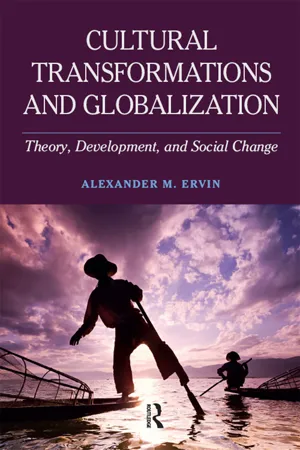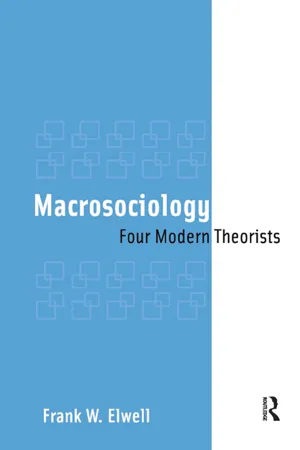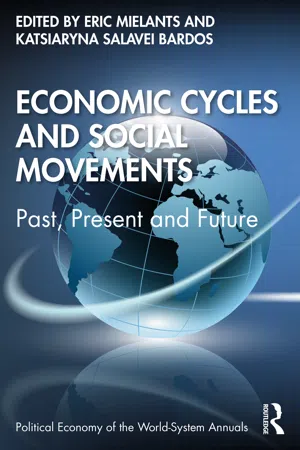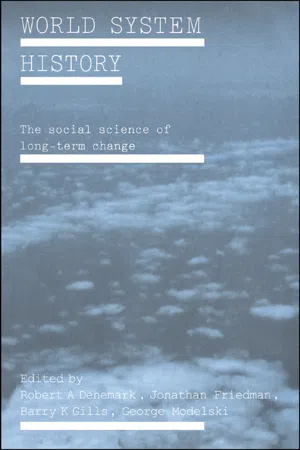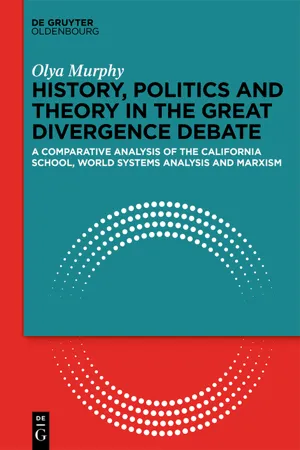Geography
World Systems Theory
World Systems Theory is a perspective in geography that examines the global economy as a complex system of interdependent parts. It emphasizes the unequal power dynamics between core, semi-peripheral, and peripheral countries, and how these relationships shape economic and social development. The theory highlights the role of capitalism and colonialism in perpetuating global inequalities.
Written by Perlego with AI-assistance
Related key terms
Related key terms
1 of 4
Related key terms
1 of 3
11 Key excerpts on "World Systems Theory"
- Athina Karatzogianni, Andrew Robinson(Authors)
- 2009(Publication Date)
- Routledge(Publisher)
2 World-system theoryThis chapter explains the world-system perspective and provides theories on global development and structural crisis. This refers to structural crisis in the world-system, and in the periphery. The chapter also discusses the state in terms of failure, transformation, capitalism and the state, and the transnational capitalist state. It includes problems of state power versus market and the state’s role in global development. Another section explores the promotion of polyarchy, the imperial executive, ambiguities of media hegemony and the state as a war-machine. The final section looks at structural cycles in the world-system, American and British hegemony, Empire and hegemonic transition, and attempting to theorise the system’s future.Explaining world-systems analysis
World-systems analysis is constructed as a long-term type of thinking in antagonism with ‘royal science’. Wallerstein argues that thinking in world-system terms requires ‘unthinking’ much of what one has learnt from the educational system and media (2004: xii). Historical knowledge as episteme has been written with or without the history of peoples and with or without the presence of archives (2004:5). Any other history describing the Other, for example Orientalism and anthropology, are viewed as about particularities (2004:9). History was written under a Western lens, developed to incorporate the Other into the narrative of Western history.For Wallerstein, world-system theory is based on a macro-perspectival understanding of history. It understands the system as a hierarchical apparatus, with a core of ‘advanced’ countries exploiting scarce technologies or patents to secure a systematic advantage, a semi-periphery of industrialised countries specialising in manufacturing, and a periphery – containing most of the global South. In a classic assertion, Cardoso similarly argued that corporations seek to maintain export of profits not only through technological monopolies but also ‘through the payment of licenses, patents, royalties and related items’ (Cardoso and Faletto 1979:91). Similarly, Samir Amin has recently argued that- eBook - ePub
Semiperipheral Development and Foreign Policy
The Cases of Greece and Spain
- M. Fatih Tayfur(Author)
- 2018(Publication Date)
- Routledge(Publisher)
th century within which the cycles and trends and social action has occurred (Hopkins and Wallerstein, 1996: 2). In the historical evolution of the world-system, Hopkins and Wallerstein identify six such distinguishable, but not separable, domains: the interstate system, the structure of the world production, the structure of the world labour force, the patterns of the human welfare, the social cohesion of states, and the structures of knowledge. These properties can be studied in their own right, or in terms of their effects on the development of national societies. However none of these properties has developed in isolation from the others, and thus any change in any one of them directly influences the others. Indeed, they form an imperfect organic whole.Modern world-system analysis is basically synchronic; it investigates the structural relations among different societies within a given time period (Bergersen, 1980: 6). In this way, modern world-system analysis tries to understand the question of how nations are interrelated with each other in the world-economy. The concepts of core-periphery relations, the division of labour, unequal exchange, and so forth are the main concerns of modern world-system analysis in explaining the interconnections among nations and long-term social changes in the capitalist world-system. In Wallerstein's words, "if there is one thing which distinguishes a world-system perspective from any other, it is its insistence that the unit of analysis is a world-system defined in terms of economic processes and links, and not any units defined in terms of judicial, political, cultural, geological etc., criteria" (Hopkins, 1977 quoted in Bergersen, 1980: 8).Nevertheless, the world-system perspective claims that economics and politics are not separate phenomena. A social system can only be understood by analysing how both power and production/wealth are organised. In this context, it looks at the political economy of the modern world-system, which focuses on the interaction and interdependence between economic and political activities. In other words, the world-system school investigates the "specific ways in which economic and political action are intertwined within the capitalist world-economy" (Chase-Dunn, 1989: 107). Accordingly, the world-system school argues that the interstate system, which is composed of unequally powerful and competing states, is the political body of the capitalist world-economy, and that the capitalist institutions of this system are central to the maintenance and reproduction of the interstate system, and vice versa (Chase-Dunn, 1989: 107). The interstate system is a creation and integral part of the modern world-system, and "above all [it] is a matrix of reciprocal recognitions of the (limited) sovereignty of each of the states, a framework that has been (more or less) enforced by the stronger on the weaker and by the strong on each other" (Hopkins and Wallerstein, 1996: 2). - eBook - ePub
An Introduction To The World-system Perspective
Second Edition
- Thomas R Shannon(Author)
- 2018(Publication Date)
- Routledge(Publisher)
World-system theory has also altered the general way in which sociologists think about the process of large-scale change. Previous general models of social change (including both classical Marxism and modernization theory) conceptualized it primarily at the societal level. The focus was on factors internal to a society that account for social change. In contrast, world-system theory has forced sociologists to consider the role of the relationships between societies in generating change within them. Thus, for example, world-system theory has insisted on viewing the rise of capitalism in the core within the context of core penetration and exploitation of the periphery. One need not accept the detailed claims of world-system theory or neglect the independent causal role of internal factors to acknowledge that at least a consideration of external factors belongs in the study of societal change.In addition, the basic idea that there is something called a world-system, with its own general characteristics and dynamics, seems to be an enduring contribution of world-system theory. It is a logical extension of the general sociological insight that social relationships of all sorts display recurrent patterns and general tendencies toward change. Whether that world-system is as the current theory characterizes it is a separate issue. Further theorizing will have to include a consideration of the possibility that there are relatively enduring global structures and dynamic processes that help shape events at the societal level.World-system theory also overcomes dependency theory's flawed conclusion that continued integration into the world-economy assures that a peripheral society will always remain a “dependent” peripheral society; “development” is always “dependent development.” This view implicitly suggests that successful industrialization can be achieved only by withdrawing from the world-system. Unfortunately (for dependency theory), this view does violence to the historical record. As we have seen, not all societies in the periphery have stayed in the periphery. Moreover, it is not clear that withdrawal from the world-system is necessarily the route to successful modernization (as the uneven success of former socialist states seems to attest). World-system theory avoids this theoretical pitfall by postulating the process of ascent (and decline) as part of the basic dynamics of the world-system. Ascent is not something accidental or unexpected but something that results from the basic functioning of the world-system (albeit, rarely). - eBook - ePub
Cultural Transformations and Globalization
Theory, Development, and Social Change
- Alexander M Ervin(Author)
- 2016(Publication Date)
- Routledge(Publisher)
Chapter Four World Systems Approaches to Cultural ChangeWorld systems analysis is an interdisciplinary field that includes sociologists, historians, political scientists, geographers, anthropologists, and archaeologists. While not completely so, much of its theoretical roots lie in political economic thought and it tends to be more deterministic in its emphasis on economic history. It also has an affinity with political ecology, as discussed in Chapter 2 . The emergence of World Systems Theory in the early 1970s was meant to unify realms of knowledge that had been split since the nineteenth century. Yet it reinforces that which should be obvious—history matters in the study of social change, especially a critical history.French economic historian Fernand Braudel, through his The Mediterranean and the Mediterranean World in the Age of Philip II (1949) and his later work Civilization and Capitalism, 15th to 18th Century (1979), germinated the elements of the theory. As pertaining to the Mediterranean, he depicted the development of interconnected trading systems beyond national and city-state boundaries, the emergence of wealthy elites and subordinate groups, and new relations and institutions that developed as a result. His approach to history went beyond chronicling events and instead incorporated climate, geography, demography, technology, transportation, and racial, ethnic, and social groups as analytical factors. There were long enduring structures to history in which relationships were consolidated and extended beyond their standard social and national boundaries. The Mediterranean was a world economic system, integrated institutionally through time and then extended during the ages of global discovery to a wider Atlantic sphere.During the turmoil of the 1960s, some scholars, such as Andre Gunder Frank and Immanuel Wallerstein, refined world systems analysis. They did this in their critical analyses of power to show solidarity with social and political movements opposing capitalist imperialism during the cold war. Just about everything in history and social science, in their view, could be put within a single framework. World systems analysis is a grand narrative, a macro perspective that abolishes all lines between historical, economic, political, and social and cultural disciplinary modes of study. It maintains that all social science has to be historical because all social phenomena need to be understood in the contexts of their emergence through time and within large interconnected, structured systems. - eBook - ePub
Macrosociology
Four Modern Theorists
- Frank W. Elwell(Author)
- 2015(Publication Date)
- Routledge(Publisher)
3 Wallerstein’s World-Systems AnalysisWallerstein is not advocating a new theory in sociology; rather he is advocating a whole new way of doing social science. The focus of social science, Wallerstein believes, is tied much too closely to the nation-state or, more vaguely, to “society.” He asserts that states as well as the organizations and groups that make up such structures exist within a much broader economic, political, and legal framework he calls “world-systems” (Wallerstein, 1974, p. 5). World-systems, according to Wallerstein, are the only true social system—they alone contain all social relations that are necessary for survival, they alone comprise the complete division of labor necessary for sustenance and growth. Nation-states must be understood in terms of the world context of their era, and modern nation-states can only be fully understood in terms of the modern world-system of capitalism. It is thus world-systems that are the proper subject of the social sciences (Wallerstein, 2000, p. 125).It is the complete division of labor that is regularly reproduced that Wallerstein takes as the defining boundary of a historical social system (Wallerstein, 2000, p. 139). A total social system must be able to meet all of the essential needs of the substantial majority of people through production and economic exchange within the system itself (Wallerstein, 2000, pp. 74–75). It is not necessary to share the same political structure or culture to accomplish this economic exchange, only that the essential needs of “sustenance, protection and pleasure” be met by a single, interdependent division of labor (Wallerstein, 2000, p. 82).By this definition, there have only been three basic types of social systems throughout history. The first are well studied by anthropologists, what Wallerstein terms as “mini-systems.” These are small in size, homogenous, relatively simple in structure (Wallerstein, 2000, p. 139). When Wallerstein also states that such societies are characterized by “reciprocity in exchanges,” he is obviously referring to such selfcontained sociocultural systems as hunting and gathering societies and perhaps simple horticultural, herding, and fishing societies. Such systems are no more. - eBook - ePub
Economic Cycles and Social Movements
Past, Present and Future
- Eric Mielants, Katsiaryna Bardos(Authors)
- 2020(Publication Date)
- Routledge(Publisher)
longue durée, there has been a constant process of spatial differentiation, a manifestation of the uneven ability of relevant actors (e.g., workers, capitalists, rulers) to protect and enhance their relative command over resources and well-being. Such spatial reconfigurations are not generally acknowledged in the relevant literature, hence the main argument of this contribution: the processes, activities, and spaces of differentiation in the world-system have always been in flux, and thereby should be established through empirical research rather than reifying categorical assumptions.What Has World-Systems Analysis Meant by “Core” and “Periphery”?
In the 1970s, world-systems scholars critically engaged both modernization and dependency theories by respectively arguing that the world-economy featured a growing gap between those at the top (core) and at the bottom (periphery) of a world division of labor and a stable third cluster (the semiperiphery) permanently situated between core and periphery (Wallerstein 1974b, 1979; Hopkins and Wallerstein 1977; Chase-Dunn and Rubinson 1977). But there has been an analytical bifurcation in the exploration of the attendant concepts. At times, authors have emphasized that each cluster of countries in this tripartite structure results from the mix of changing economic activities contained within territorial boundaries. Along these lines, for example, Immanuel Wallerstein argued that through various mechanisms, some economic activities (core-like) produced comparatively high profits and thereby derived the greater share of the wealth generated by the world division of labor. Other economic activities (peripheral) featured low-profits and derived the least benefits from the world division of labor. Semiperipheral areas are characterized by a more or less even mix of core and peripheral activities. Such a depiction, emphasizing world-historical specificities, tends to emphasize change over time in the economic activities providing access to greater or lesser shares of wealth (e.g., textile manufacturing had been a “core” activity at one point in time but eventually became “peripheralized”), in the geographical location of these activities (e.g., countries and areas may “move” between zones), and in the specific mechanisms producing unequal distributional outcomes (e.g., colonialism may have played a role at one point in time, but eventually became less relevant).2 - eBook - ePub
New Age Globalization
Meaning and Metaphors
- A. Ahmad(Author)
- 2013(Publication Date)
- Palgrave Macmillan(Publisher)
His more recent works define it as world systems analysis (WSA), although most literature still uses the original term WST. 21 Other scholars have also made important contributions to this formulation under the umbrella of political economy of capitalism. For example, Christopher Chase-Dunn and Salvatore Babones have compiled 16 highly critical essays on the “corporate globalization movement” in the classical tradition of WST, all pointing out the negative consequences of global economy for local environments, labor relations, women’s rights, and social equality, with the possibility of spawning reactive transnational social (Socialist) movements. 22 For the sake of convenience and avoidance of controversy, I treat dependency theory and WST in this work as variations of each other. Both rest on similar assumptions about the nature, causes, and consequences of the capitalist world economy in terms of unequal distribution of global power and resource exploitation by few at the expense of many, particularly in the colonial and postcolonial (imperial) political economies. A modernization theorist would attribute global system maintenance to the interlocking interests of the system members, in this case the national societies, as the contributors to and beneficiaries of international political and economic institutions. The WST and dependency theory, on the other hand, would attribute such maintenance to the dependency of the powerless on the coercive power of the powerful, akin to social control in a police state where noncompliance could lead to serious consequences for the noncompliant - eBook - ePub
World System History
The Social Science of Long-Term Change
- Robert. A Denemark, Jonathan Friedman, Barry K. Gills, George Modelski, Robert. A Denemark, Jonathan Friedman, Barry K. Gills, George Modelski(Authors)
- 2002(Publication Date)
- Routledge(Publisher)
The debate between 500 and 5,000 years of world system history is really about how to write world system history. It is a debate about continuity versus discontinuity. One position is that the mode of production or social formation in world history makes a sharp break about 1500. This position is dominant among historians and world-system theorists, including Wallerstein and Amin. The other position is that capital accumulation did not begin or become ‘ceaseless’ only after 1500 AD, but has been the motor force of the historical process throughout world system history. There was no such sharp break between different ‘world-systems’ or even ‘modes of production’ around 1500.The real disagreement revolves around the question of what structures constitute a ‘system’ or a ‘world(-)system’ in particular. We contend that a hierarchy of center-periphery (and hinterland) complexes within the world system, in which surplus is being transferred between zones of the hierarchy, necessarily implies the existence of some form of an ‘international’ (at best a misleading term) division of labor. A criterion of systemic participation in a single world system is that no part of this system would be as it is or was if other parts were not as they are or were. The interaction from one part of the system to another may be only indirectly chain-linked. A weaker systemic link would be that the various parts may also have reacted to, and on, the same global ecological constraints. In Gills and Frank (1990/1) we suggestThe capture by elite A here…of part of the economic surplus extracted by elite B there means that there is ‘inter-penetrating accumulation’ between A and B. This transfer or exchange of surplus connects not only the two elites, but also their ‘societies” economic, social, political, and ideological organization…This inter-penetrating accumulation thus creates a causal interdependence between structures of accumulation and between political entities…That is ‘society’ A here could and would not be the same as it was in the absence of its contact with B there, and vice versa.Despite our emphasis on ‘economic’ connections to cement the world system, we also accept the world system connections established and maintained through recurrent ‘political’ conflict among ‘societies’ as emphasized by Wilkinson (1987a). The recognition of such conflict as a mark of participation in the same world system is all the more important insofar as much of the conflict has been over economic resources and control of trade routes. Conversely, trade in metals and/ or weapons could increase military capacity and enhance control over sources of economic resources, including trade itself. Political conflict has also been the expression of the alternation between hegemony and rivalry within the world system and/or its regional parts. - eBook - ePub
- Stephen Stetter(Author)
- 2007(Publication Date)
- Routledge(Publisher)
The emergence of regional differentiations in world society hence ‘produces within different functional systems different borders for the different regions’ (Stichweh 2000b:200). Moreover, these manifold regional borders are not static lines of distinction but are subject to constant communicative bordering practices that either do or undo these spatial distinctions. Secondly, in order to be recognized as a distinct region in world society there needs to be at least some congruence between territorial division within different functional spheres without amounting to a complete overlap between identical spatial borders across various functional spheres. This latter example would indeed be a problematic empirical reality for modern systems theory. Thus, if ‘regional differentiation assumes a primacy over a functional differentiation of world society, then the empirical validity of the very concept of world society might be put into doubt and, arguably, be replaced by a view of the global system which starts from the premise of a continued existence of many societies. These may then very well interact, yet would not have led to the emergence of world society as one social system’ (Albert 2004c:23). Yet, against the background of global communicative interconnectedness and global structures that can be found in societal communication throughout the world, theories that postulate such different regional societies face certain difficulties. Thus, they would have to show that the regional level determines developments at the global level rather than global structures permeating into (and adapting to) regional contexts. While this view could indeed be accommodated with theories of power and hierarchy, for example theories of global centre-periphery relations, another issue seems to be more problematic - eBook - ePub
Mass Education, Global Capital, and the World
The Theoretical Lenses of István Mészáros and Immanuel Wallerstein
- T. Griffiths, R. Imre(Authors)
- 2013(Publication Date)
- Palgrave Macmillan(Publisher)
Consistent with Wallerstein’s position with respect to orthodox Marxist perspectives, the thesis of transition toward an alternative but uncertain world-system is quite distinctive, rejecting accounts of national societies progressively moving through sequential stages of feudalism, capitalism, socialism, and communism. As Mielants (2012, 59) highlighted in his summary of the debates over the nature and temporal location of the transition from feudalism to capitalism, world-systems analysis is in the unusual position of being criticized for being Marxist by liberal and Smithian theorists, while “Orthodox Marxists claim no affiliation with the perspective.”In short, the thesis here is that regular cycles of expansion and contraction are characteristic of the capitalist world-economy, as leading and usually monopolistic industries in core zones fuel growth and accumulate high levels of capital, before increased competition and overproduction lead to declining rates of profit and recession. It is through this regular cycle of expansion and contraction that industries are relocated to other zones of the world-economy, in search of cheaper labor to restore rates of profit, accounting for a series of shifts over time of industrial activity from the core to the semi-periphery and periphery as the core areas invest in new “quasi-monopolies” that drive the next cycle of expansion and capital accumulation.Perhaps the most emblematic example is textile production, which “circa 1800 . . . was possibly the preeminent core-like production process . . . [but which] . . . by 2000 . . . was manifestly one of the least profitable peripheral production processes” (Wallerstein: 2004c, 29). While each cycle restores the world-economy to some sort of equilibrium, Wallerstein’s perspective is that the recurring cycles contribute to longer-term secular trends, whereby structural contradictions that are associated with these cycles and characteristic of the capitalist system as a totality are moving toward their absolute limit, or asymptote, and the “disintegration” of the prevailing historical world-system.Wallerstein’s theorizing has identified several dimensions of the systemic crisis, leading to a phase of crisis and transition toward an uncertain alternative. Most crucial is an identified long-term trend of pressures on the systemic imperative to maximize the accumulation of capital. The cyclical and longer-term pressure on profits and capital accumulation has multiple sources. First, Wallerstein’s analysis repeatedly cites the orthodox tension faced by capital seeking to reduce wages as a cost of production to boost profits, and to increase rates of consumption and so demand as a strategy to maintain profits, the latter requiring higher wages. This involves a contradictory requirement for low-rates of fully proletarianized labor to support low-wages, and higher rates to increase demand and consumption. The relocation of production to semi-peripheral and peripheral areas involves the move to areas with lower wages supported by semi-proletarianized labor (Wallerstein: 1979), such that “it becomes very clear that geographical expansion of the world-system served to counterbalance the profit-reducing process of increased proletarianization, by incorporating new work-forces destined to be semi-proletarianized” (Wallerstein: 1983, 39). - eBook - ePub
History, Politics and Theory in the Great Divergence Debate
A Comparative Analysis of the California School, World-Systems Analysis and Marxism
- Olya Murphy(Author)
- 2023(Publication Date)
- De Gruyter Oldenbourg(Publisher)
3 Wallerstein contends that this shift necessitated and therefore explains the international division of labor and specialization, which led to capital accumulation and economic growth at historically unprecedented levels. The shift occurred within an already existing international market centered in Europe, which first developed in the Mediterranean on the basis of south European trade (partly with the Islamic world), and which later moved to the northwestern parts of Europe while also expanding into the “New World.”The most important characteristic of this system is that its dynamism and growth required simultaneous development of the core, where capital accumulation occurs, and the periphery, which provides surplus for the core’s development. Development and underdevelopment are both necessary features of the system. What distinguished this system from imperial domination is the economic nature of the surplus transfer. Military and political power did play a role to establish and maintain economic dominance of the core, but Europe lacked a sufficiently powerful state to establish its political control over the whole trading region to become an empire. Instead, the core – parts of Europe originally – developed into a set of political units competing with each other, but also maintaining a balance of power. The market became the main mechanism for the functioning of the system. Once the market became the organizing mechanism of the world-economy, production for profit in the world (as opposed to home) market became the defining feature and organizing force of all economic units and actors. For Wallerstein, this is capitalism.Is WSA Eurocentric? It does place the origins of capitalism in Europe and dates the divergence much earlier than do the Californians – the sixteenth century. But why should these ideas be viewed as “Eurocentric,” at least in any negative sense of the term? Wallerstein argues that capitalism emerged as a “world-economic” system in Europe, that its original center of power was in Europe and that it later spread to the broader “West.” This is hardly to be dismissed on the grounds that it is a pro-European claim or prejudice. By analogy, no one would regard it as Eurocentric to argue that fascism was born in Europe. It is probably because capitalism has many more enthusiasts than fascism (although this difference may be diminishing) that it becomes tempting to level a charge of “Eurocentrism” at any analysis (or analyst) placing Europe at the center of the origins and spread of this system. This is thought to be unfair to the non-European world. But what is truly problematic, according to critics of capitalism, is the uncritical celebration of capitalism as a human achievement, as the best of all possible worlds, as the system to which there are no feasible or desirable alternatives. If anything, this attitude may plausibly be said to be Eurocentric. Celebrating capitalism often means, in effect, celebrating the unprecedented power it gave first to Europe and later to the Global North, particularly its elites, to dominate and exploit much of the world’s population. Celebration of capitalism tends to blind us to the global costs and consequences of this power; it provides ideological ammunition for the perpetuation of class exploitation and contributes to existing and growing inequality both within and between countries.4
Index pages curate the most relevant extracts from our library of academic textbooks. They’ve been created using an in-house natural language model (NLM), each adding context and meaning to key research topics.
Explore more topic indexes
Explore more topic indexes
1 of 6
Explore more topic indexes
1 of 4
